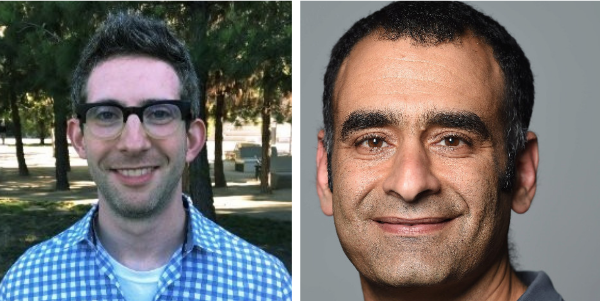Parshah Pinchas
An Israeli and American duo met to learn the weekly Torah portion together. In the process, they discovered they had two totally different but equally meaningful interpretations of the same text. Eyal’s perspective incorporates the words of Israel’s beloved national poet, Chaim Bialik, while Brad’s perspective grounds us in the census-like American recordkeeping during the pandemic. While their perspectives are different, their conclusions about what we can learn from the Parshah are universal and can apply to us all. Please enjoy the first-ever Double D’var: Parshah Perspectives brought to you by BaInyanim at the ICC@OFJCC.
Eyal Akiva moved from Israel to the Bay Area in 2010 with his wife, Dafna, and two kids, Naama and Yoav. Following two postdoctoral fellowships at UCSF, he joined the biotech industry, and is now working as a staff bioinformatics scientist in a food tech startup in the field of alternative proteins. He has been active in the local community by participating in the ICC@JCC’s Gvanim program, volunteering, studying Talmud, co-establishing a Talmud study group and writing commentaries to weekly Torah portions.
Brad Heller is a scientist from New York who moved to San Francisco in 2014 to take a postdoctoral position at UCSF. He has since moved to Los Angeles with his wife where he is working on a new venture called Achieve Clinics that will make cell therapy more effective and less expensive.
Says Eyal, “Brad and I have known each other for seven years, ever since we were postdoctoral fellows at UCSF. Back then, we organized student events based on the Jewish calendar; we even got to set up a sukkah in the green courtyard of Mission Bay campus! Now, we regularly study Talmud in English (with short forays into Hebrew and Aramaic).
“Recently, during a meeting of Parshah commentators that publish in the ICC@JCC’s online Bainyanim newsletter, the idea of writing commentaries in English and Hebrew by writers from both communities was suggested. The Jewish scriptures can serve as a fundamental common ground and meeting point between Israelis and Jews born here, and the attempt to decipher the text together from two perspectives—including mutual feedback and conversation—can bring us closer and promote deeper mutual understanding.
“We found that the combination of the clear translation of the Torah into English and the richness of reading the Torah in its source language complement each other. That being said, our perspectives of the same text are totally different. The first bilingual Torah interpretation is hereby published, and we hope the trend will continue!”
(Scroll for English.)
מספר הפלא 600,000 / אייל עקיבא
מה השמות של ספרי התורה באנגלית? אני מודה שאני תמיד שוכח… ספר “במדבר” בו מצוייה פרשת השבוע, פרשת “פנחס”, נקרא “Book of Numbers” בואו נאמר שזה לא בדיוק איך שגוגל היה מתרגם. מדוע הוא נקרא כך? כי יש בו הרבה מספרים – למשל תוצאות “מִפְקַד האוכלוסין של הלשכה המדברית לסטטיסטיקה” שפורסם השבוע בפרשה. משה מבקש “שְׂאוּ אֶת־רֹאשׁ כׇּל־עֲדַת בְּנֵי־יִשְׂרָאֵל מִבֶּן עֶשְׂרִים שָׁנָה וָמַעְלָה לְבֵית אֲבֹתָם כׇּל־יֹצֵא צָבָא בְּיִשְׂרָאֵל”. מדובר באחד מתוך שלושה מפקדים בספר במדבר ‐ השניים האחרים נערכו 38 שנה לפני כן, מיד אחרי יציאת מצרים. קצת הופתעתי לקרוא שמספר בני ישראל בכל המפקדים היה זהה – כולם היו סביב “מספר הקסם” שש-מאות אלף. למה בכלל לספור? איך זה שתמיד המספר זהה? האם יש משמעות מיוחדת למספר 600,000?
הנה קטע שמצאתי באתר הלמ”ס: “בעולם העתיק נערכו מפקדים לצורך מיסוי, גיוס לצבא, ובקרה של המבנה החברתי…מטרתם הייתה חיזוק השלטון המרכזי… במדינות מודרניות דמוקרטיות המפקדים נועדו לאסוף מידע חיוני למילוי חובתה של המדינה לשרת את האוכלוסייה”. לא אתווכח עם חכמינו מציון, אבל פרשנותם כאן די קולעת ‐ בני ישראל נמצאים על סף הכניסה לארץ המובטחת, רגע לפני עימותים צבאיים רבים. פשוט סופרים את הגייסות. המפקד הנוכחי שימש גם לתכנון חלוקה שוויונית של הארץ, כל שבט לפי גדלו (מפתיע – לא לפי כוחו הצבאי או הפוליטי) ‐ “לָאֵלֶּה תֵּחָלֵק הָאָרֶץ בְּנַחֲלָה בְּמִסְפַּר שֵׁמוֹת. לָרַב תַּרְבֶּה נַחֲלָתוֹ וְלַמְעַט תַּמְעִיט נַחֲלָתוֹ אִישׁ לְפִי פְקֻדָיו יֻתַּן נַחֲלָתוֹ”. מעניין גם שהאנשים שנספרו בפרשת “פנחס” היו אחרים בתכלית מאלה שנספרו במפקדים הקודמים. למעשה – חוץ ממשה, יהושע וכלב בן יפונה, כל הדור הקודם, יוצאי מצרים, מתו במדבר כעונש על חטא המרגלים. שוני נוסף הוא שבניגוד למפקדים קודמים, בהם הוזכרו ונספרו השבטים כיחידות הַמְּנִיָּה, הפעם הוזכרו בשם גם כל המשפחות בכל שבט ושבט. הדור הנספר עתה לא מסתפק בשיוך לשבט, אלא למשפחה. הדור הקודם היה אחיד יותר, נע ביחידוֹת של שבטים, בדור הנוכחי ‐ לכל אינדיבידואל יש שיוך משפחתי ‐ ולכל משפחה כבר יועדה נחלה מיוחדת לה בארץ המובטחת. אולי חל כאן תהליך של הכרה ברזולוציה הולכת וגדלה – מעם לשבטים ולמשפחות. מתמונה אחידה לתמונה רגישה יותר לפרטים. לבסוף ‐ גם המשימה והייעוד של הדורות האלה היו שונים. דור אחד יצא ממצרים, השני ‐ נכנס לארץ ישראל.
כשקראתי את החלק הזה בפרשה נזכרתי בשיעור ספרות לפני כ-30 שנה, בו שמעתי את תיאורם של שני הדורות האלה. לפי התיאור הזה, מה שנשאר מדור מתי המדבר הוא אתר רחב ידיים, צחיח ונשכח המלא בשיירים מאובנים של אותם שש-מאות אלף (פחות שלושה) ‐ תיאור בעברית יפהפיה ומלאת הוד ואבק. התיאור של הדוֹר הנספר עתה היה אחר לגמרי:
“פֶּתַע פִּתְאֹם יִתְנַעֵר דּוֹר עִזּוּז וְגִבּוֹר, דּוֹר גִּבּוֹר מִלְחָמָה
…
וְהִרְעִימוּ אַדִּירִים בְּקוֹלָם, קוֹל שִׁשִּׁים רְבָבָה,
…
וַנִּזְקֹף רֹאשֵׁנוּ שָׁמָיְמָה וַיֵּצְרוּ בְעֵינֵינוּ –
וַנַּעֲרֹק לַמִּדְבָּר וַנֹּאמַר לַצִּיָּה “אִמֵּנוּ!”
עַל-רָאשֵׁי הַצּוּרִים בֵּין מִפְלְשֵׁי עָבִים
שָׁתִינוּ מִמְּקוֹרוֹ הַדְּרוֹר עִם כָּל-נִשְׁרֵי שָׁמַיִם –
וּמִי אָדוֹן לָנוּ?!
גַּם-עַתָּה – אִם-סָגַר עָלֵינוּ מִדְבָּרוֹ אֵל נָקָם,
כִּמְעַט נָגַע בָּנוּ שִׁיר עִזּוּז וָמֶרִי – וַנָּקָם!”
(מתי מדבר/ ח”נ ביאליק).
בשנת 1901, ביאליק מתכתב עם המקורות, מזכיר את “מספר הפלא”, שישים ריבוא, ולמעשה מתאר – שלושה דורות – דור מתי המדבר, הדור העומד על סיפה של הארץ, ועוד דור – זה שהתקבץ להקים את מדינת ישראל – שאף הוא יִמְנֶה, כעבור 47 שנה מכתיבת הפואמה, שש מאות אלף אישה ואיש. ביאליק חוזה שהדור החדש גם הוא יהיה חלק ממהלך היסטורי: אותו מספר, 600,000. כולם אוחזים בחזון גדול וביכולת ליצור משהו חדש – בדרך אחרת מזו שנקטו בה אנשי הדור הקודם, שכן זו נכשלה.
מה יש במספר הזה? האם זהו הגודל המינימלי של קהילה שיש בה מספיק שונות וכוח להגדיר עצמה באופן משמעותי ולחולל שינוי?
איפה עוד יש 600,000 סביבנו? ממש קרוב! שש-מאות אלף הוא גם מספר היהודים החיים פה במפרץ. המספר הזה צץ שוב כשחיפשתי מפקדים עדכניים, ומצאתי שראשית, מספר ה”שבטים” הצטמצם משמעותית. שנית, במפקדים של היום יחידת הספירה היא households ‐ כלומר ייצוג ברזולוציה גבוהה יותר. שֵׁם המשפחה כבר אינו מספיק, יחידת המניה היא אנשים החולקים את אותה קורת גג. לבסוף, מצאתי שיש שוני עצום בהערכות של מספר הישראלים החיים במפרץ (שאינם נספרים ע”י אף גוף רשמי). בשורה התחתונה, סך היהודים החיים כאן הוא כשש-מאות אלף (ישראלים מהווים– 15-5 אחוז). אז אנחנו כאן, ומספרנו זהה לזה שהתפקד בכניסה לארץ. דור המדבר? דור על סף שינוי?
אני קורא את הפרשה והמחשבות שלי נעות בין הדור ההוא שהלך במדבר, לבינינו – פה ועכשיו. האם לקהילה/ות השונה/ות יכול להיות חזון משותף, חדש ובר-מימוש, כזה שאינו משותף עם דור ההורים? אולי… בכל מקרה, נראה ששני מרכיבים לפחות נחוצים כתנאים מקדימים: צעדים קטנים (למשל שיתופי הפעולה בין ה OFJCC ל-ICC, ומפעלים כגון כתיבת פרשנות דו-לשונית לפרשת השבוע…), והנכונות של שני הצדדים להשתנות בכדי לשנות – (“אדם יכול להשפיע על אחרים רק במידה שהוא נשפע מהם על פי דרכו, באופן מיוחד לו, ואת השפע הזה המיוחד לו ישוב וישפיע עליהם” (א.ד. גורדון, “מכתב שלא נשלח בזמנו”).
נתראה במפקד הבא!
===
600,000: The Magic Number
by Eyal Akiva
What are the names of the books of the Torah in English? I admit I keep forgetting… This week’s Parshah, ‘Pinchas’ is part of “Bamidbar,” known as “The Book of Numbers” (“Bamidbar” means “In the desert,” which is not the same as “numbers.”) Why? Because it has many numbers in it. For example, the results of the “Census of the Desert Bureau of Statistics” are published this week in the Parshah. Moses asks, “Take a census of the whole Israelite community from the age of twenty years up, by their ancestral houses, all Israelites able to bear arms.” This is one of three censuses in the Book of Numbers; the other two were conducted 38 years earlier, just after the Exodus. I was surprised to realize that the number of Israelites counted in all the censuses was the same—they were all around the “magic number” of six hundred thousand. Why were these censuses conducted? How come they all ended up with the same count? Is there any hidden meaning to this number, 600,000?
Here is what I found on the website of the Israeli Central Bureau of Statistics: “In the ancient world, censuses were conducted for the purpose of taxation, conscription, and control of the social structure. Their purpose was to strengthen the central government… In modern democratic countries, the censuses’ purpose is to gather vital information to fulfill the duty of the state to provide services to the population.” I will not argue with our modern sages of statistics, and I feel they were right in the sense that the people of Israel were on the verge of entering the Promised Land, just before multiple military clashes. They just counted the soldiers. This census was also used to equally divide the Promised Land, each tribe according to its size (surprisingly, not according to its military or political power) — “Among these shall the land be apportioned as shares, according to the listed names: with larger groups increase the share, with smaller groups reduce the share. Each is to be assigned its share according to its enrollment” (Num. 26:53-54).
It is interesting that the people counted in the “Pinchas” census were completely different from those counted in the previous censuses. In fact, except for Moses, Joshua and Caleb son of Jephunneh, all the previous generation, the participants of the Exodus, were gone. They all died in the desert as punishment for the sin of the spies. Another difference is that unlike previous censuses, in which the tribes were mentioned and used as a basic counting unit, this time all the names of the families within each tribe were used as the basic counting unit. The current generation is not satisfied with being affiliated with a big tribe, but rather with a family. The previous generation was more uniform, it moved in 12 tribal units, while now each individual is affiliated by name to a family, and each family is allotted a specific portion of the land of Israel. Perhaps one can recognize an increase in sensitivity—from people to tribes to families. From a uniform perspective to a reflection more sensitive to individuals and their aspirations. Finally, The mission of these generations was also different. One generation came out of Egypt, the other entered the Land of Israel.
When I read this part of the parshah, I remembered a literature studies class I attended in high school, about 30 years ago, where I heard the description of these two generations. According to this description, what was left of the people that died in the desert is a vast, arid and forgotten site full of fossil remains of those six hundred thousand (minus three)—a description in beautiful Hebrew full of grandeur and dust. The description of the generation that followed was totally different:
Suddenly, a generation will shake itself, a generation mighty and valiant,
a generation strong in battle,
…
And they thundered in their mighty voice, a voice of six hundred thousands
…
We raised our heads to the sky but found it constricted in our eyes –
We deserted to the desert, and named this wilderness: “our mother”!
On the top of the mountains, between the clouds
We drank freedom from its source with the heaven’s eagles –
Who is our lord?!
Even if a vengeful God would have engulfed us with his desert,
a song of strength and revolt would have touched us – and we shall rise!”
—”The Desert’s Dead” by Chaim Nahman Bialik, Israel’s national poet
In 1901, Bialik engages with the scriptures, mentions the “magic number” of 600,000 and essentially describes three generations: The desert’s generation, the generation standing on the brink of the Promised Land, and yet another generation, the one gathered to establish the state of Israel. Forty-seven years after Bialik wrote this poem, their count was the same—600,000 women and men. All having a grand vision and the ability to create something novel, in a manner different from previous generations, since their ways were not successful.
What’s in this number? Is this the minimum size of a community that has enough diversity and power to define its identity and bring about change?
Where else are there 600,000 around us? Really close to home! Six hundred thousand is also the number of Jews living here in the Bay Area. That number popped up again when I was looking at the most recent census. First, I found that the number of “tribes” had decreased significantly. Second, in today’s censuses the count unit is households—representing even higher parallel to the biblical censuses. The family name is no longer enough—the base unit is people that live under the same roof. Finally, I found that there is a huge difference in the estimates of the number of Israelis living in the Bay (they are not counted by any official establishment). The bottom line is that the total number of Jews living here is about six hundred thousand (Israelis make up around 5-15%). So we’re here—the same number as the people that were close to entering the Land of Israel. A generation of the desert? A generation on the brink of change?
I read the Parshah and think about the other generation that was walking in the desert, and our generation—here and now. Can our community/(ies) have a shared, novel and achievable vision, one that was not fulfilled by the older generation? Perhaps… In any case, at least two elements seem to be necessary as preconditions: Making small steps (e.g. the cooperation between the American and Israeli communities here in Palo Alto at the OFJCC, and initiatives such as writing bilingual commentaries on Torah portions…), and the willingness of both communities to change in order to make change. “One can affect others only to the extent that one is influenced by them in his/her own way, in a way that is special to him/her, and that affection that is special to him/her can affect the other” (from “A letter not sent in time” by Aharon David Gordon).
See you at the next census!
===
Count our Blessings
by Brad Heller
Our weekly Parshah begins with Pinchas’s act of zealotry that effectively ends a plague—perhaps one not unlike COVID-19. Once the plague was over, the very first thing that Moses and Eleazar did as leaders was to conduct a census—a count of the survivors (“Take a census of the whole Israelite community from the age of twenty years up, by their ancestral houses, all Israelites able to bear arms.”). Much commentary exists about why the census was taken after the plague, and the simplest explanation is that “whenever the Israelites were struck, they needed to be counted, as a shepherd will count the sheep after a wolf attacks” (Midrash Tanhuma Pinchas 4). This is the opposite of what we have been doing since last March, that is counting the number of those who became sick and died. We are not taking a count of those who live.
It is tempting to conclude simply that the lesson is to focus on survival, not suffering. But the Talmud (Taanit 8b) doesn’t let us off so easily. The sages cite a situation in which someone enters their barn to retrieve grain. The appropriate blessing has to be said before the grain is measured. Otherwise, if said afterwards, it is considered a futile blessing. This is because you can only bless that which is hidden from sight. A blessing is a matter of faith—and you don’t need much faith once you’re sure you have what you want.
So if the blessings on grain that was already measured are in vain, what does that mean for blessings on survivors of a catastrophe after they are accounted for? Indeed, the Talmud debates this as it pertains to the census in Parshat Pinchas. Perhaps our inclination to focus on those who perished from COVID-19 may not be so bad after all.
As COVID-19 ebbs in America, it continues elsewhere and we do not know how many more will die, let alone how many will survive. But we have learned here that it is precisely this ignorance of outcomes that creates space for faith and the opportunity to make meaningful blessings: A blessing for those who developed the vaccines, a blessing for the frontline workers who continue to keep our society functioning and a blessing for the rest of us to strengthen our community as it recovers and assists those who still struggle.








Comments are moderated and will not appear immediately.